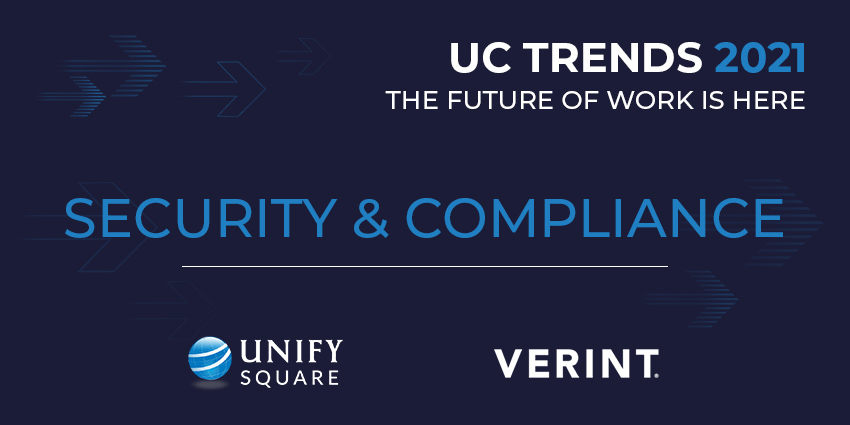As the trends of the communication and collaboration industry continue to evolve, there’s one thing that will always remain crucial for today’s business leaders: security and compliance.
While businesses have always prioritized the security of their organisations, data, and customers, the demand for better standards in privacy and protection has grown in recent years. We’ve seen the evidence of increased demand for security in everything from the introduction of GDPR to the arrival of new standards for data management worldwide.
As the landscape continues to change, bringing with it more mobile workers, distributed teams, and updated communication platforms, questions around compliance and privacy are evolving. Companies are under greater pressure than ever to keep their teams and clients secure in a transformational landscape.
To find out where this space is going, we reached out to leaders from innovative companies like Unify Square and Verint. Here’s what they had to say about Security and Compliance 2021.
What are the Most Significant Customer Trends from 2020?
To understand where the security and compliance space is heading, we need to fully grasp where it is today. Right now, communication and collaboration landscapes are in a state of significant transformation, with around 90% of organisations involved in some kind of migration towards new technology. Unfortunately, while access to new technology unlocks opportunities, it also presents significant challenges too.
Switching into a new landscape, like one for remote working in the age of COVID-19, or one that focuses heavily on tools for collaboration and video conferencing, means addressing new security and compliance issues.
Scott Gode, Chief Product Marketing Officer at Unify Square:

According to the Chief Product Marketing Officer for Unify Square, Scott Gode, data security, particularly regarding collaboration platforms, is the number one item on the list of Enterprise priorities right now. This is particularly essential at a time when the workforce is becoming increasingly remote and hybrid.
When it comes to ensuring collaboration security, Scott says that a few significant customer trends stand out. First, there’s an aggressive migration to and adoption of SaaS platforms. Secondly, companies are dealing more aggressively with shadow IT deployments, and “lightly managed” IT touch on various workloads. “This results in multiple platforms in use per organization covering the same workload.”
Finally, the third trend is a fast-tracked evolution in security trust models like MFA and VPN split tunnelling.
Phil Fry, Vice President of Financial Compliance at Verint:

Phil Fry, the VP of Financial Compliance for Verint said that clearly, 2020 hasn’t been a normal year. The pandemic has forced us to change how we operate, particularly as the workforce switches to working from home. This creates various issues. For instance, there are new cultural challenges to consider due to people working in unfamiliar surroundings.
Secondly, there are technical and managerial concerns associated with equipping employees to work safely, effectively, and securely wherever they are. This year has significantly accelerated the trends already underway in the workplace. Chief among these is the increased adoption of collaboration and UC tools, such as Microsoft Teams. These tools help close some of the distance caused by remote working with video, screen sharing, and instant chat.
“This in turn has prompted a move towards cloud-based communication and data management solutions, but also creates a critical “compliance gap” for regulated businesses required to capture and store electronic communications.”
What Will Be the Top Challenges Facing End Customers in 2021?
In 2021, as the demands on businesses continue to evolve, there’s no doubt that we’ll continue to discover new challenges that brands need to overcome in security and compliance. Although we’re already in a period of transformation now, the new year is likely to focus on the ongoing strategies that companies will need to put in place after the COVID-19 pandemic.
We asked our industry leaders what they think the biggest challenges will be facing end-customers in the year to come.
Unify Square’s Scott Gode said that in the UC and Collaboration world, complex challenges from 2020 are likely to flow into 2021. This includes the challenge of enabling users to collaborate securely from anywhere, while protecting data from misuse. There’s also the challenge of governance confusion to consider. “Configuration drift and misconfiguration of workload settings increases data risk and issues with governance structures.”
Scott noted that cloud speed to security posture mismatches will be an issue too. SaaS enables agility and speed, but out-of-the-box settings haven’t caught up with enterprise needs for risk and security management. Employee security awareness will be another issue to address, as companies strive to avoid the over-sharing of data and excessive privileges, combined with limited training available during the work-from-home shift.
Even home network and UC workload support could be a challenge, as users will need 24/7 operational lifecycle support, as well as work/life balance support too. “While not directly a security issue, the WFH culture creates added stress…and stress can translate to lack of focus and/or unintentional negligence.”
Phil Fry of Verint said that given the trends towards increasing adoption of UC for support of remote working, it’s likely that 2021 will be a year of consolidation and stabilisation for most businesses.
“Most organizations will be playing “catch-up” – to some extent or another – and a particular emphasis for many will be imperative to ensure that the new communication and collaboration technologies they have put in place, properly support compliance with applicable regulations.”
According to Fry, companies will need to adjust internal standards and controls, considering changes to communication channels and infrastructure, and the need to ensure data privacy and integrity aren’t compromised by new working practices and solutions. Businesses will also need to think about the impact of increased remote working on standards for employee conduct.
“Many businesses, although it is not yet clear how many, will also need to cope with assimilating the consequences of adopting new tools and modes of working, while also managing the return to normal workplaces.”
Which Technology Will Deliver Most Value to Customers in 2021?
With so many issues to address and challenges to overcome in the security and compliance landscape, companies everywhere will be turning to disruptive technology to help them thrive. Already, we’re seeing an influx of changes in the digital landscape, with the rise of new encryption strategies and security standards.
Vendors in collaboration and communication are experimenting with tools like artificial intelligence and biometrics to add greater security to the way that we connect. So, which technology will have the most significant influence going forward?
According to Chief Product Marketing Officer for Unify Square, Scott Gode, it’s crucial to define the customer from both an IT and end-user perspective to answer this question. For business users, collaboration platforms like Zoom and Microsoft Teams will enhance flexible collaboration in decentralized workforces.
“For IT Professionals, advanced software tools which provide both workplace analytics insights (including threat detection), as well as the ability to manually (and automatically using machine learning) create and enforce policies to support organizational governance structures are emerging as the big 2021 focus in the collaboration market.”
According to Gode, the ability to provide proactive visibility, compliance, and remediation checking in the UC and collaboration space will be essential to overwhelmed IT departments.
Verint’s Financial Compliance expert, Phil Fry said that the far-reaching and unexpected nature of the pandemic caught most of the organisations in the current space off-guard. COVID-19 forced a level of velocity of technical and organizational adjustments that most of us haven’t seen for many years.
“Given that we are not clear of the pandemic yet and have all been reminded of the power of events, technology that can rapidly adapt to embrace new communication modes and working practices, would appear to be “must” for the future”
Regulated companies must retain control of all the data and technology they require to ensure ongoing compliance, no matter what might be happening around them. Intelligent controls and monitoring based on machine learning, automation, and big data analysis will have a crucial role to play here. These things will be backed up by open integration abilities that allow businesses to support an ecosystem of best-in-breed solutions.
What is Your Prediction for The Biggest Game-Changing Trend For 2021?
It’s difficult to know for sure what the most significant changes will be in the years ahead. No-one could have predicted how 2020 would have transformed the way that we meet and communicate at such a massive scale. Going forward, it isn’t easy to know what the most significant trends might be for safety and compliance.
We asked our industry leaders for their thoughts on where the industry might go next and what companies should be aware of.
Scott Gode, Chief Product Marketing Officer at Unify Square:
Chief Product Marketing Officer for Unify Square, Scott Gode, told us that COVID-19, mixed with some high-profile security exposures in Zoom video conferencing, has already pushed some significant changes. There’s a massive IT shift taking place in the collaboration and UC world. WFH work practices by end-users are also exacerbating this shift.
“Employees tend to work more casually while at home, and some of that informality unconsciously leads to more lackadaisical security practices. The “old” IT focus was on call quality and availability.”
“In 2021 IT will spend significantly less time chasing call quality gremlins in their network and more time monitoring, configuring, and securing their collaboration and UC platforms”
Phil Fry, Vice President of Financial Compliance at Verint:
VP of Financial Compliance for Verint, Phil Fry said that it’s challenging to pick one game-changing trend among the many likely to appear going forward. It seems that we’ll soon be welcoming an era of proactive compliance in the landscape, with advanced analytical tools that monitor a range of things, from technical performance, to personal activity.
Searching for the tell-tale signs of non-compliance and alerting managers in real-time will be crucial in the years ahead. “We are also passionate about the need to embrace open standards that will support cradle-to-grave capture, analysis, and intelligence for compliance functions and data. This should include automation and intelligence that will help organisations to maintain, and demonstrate that they maintain, control over essential data.”
Fry also noted that we shouldn’t rule out the possible introduction of new communication modes and technologies like augmented and virtual reality, and what these could mean too.







